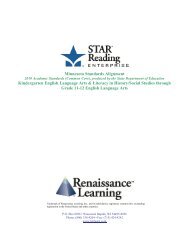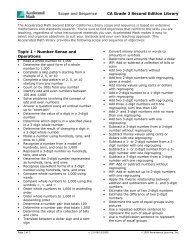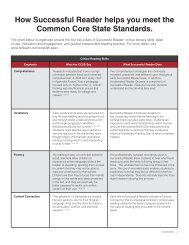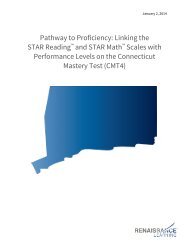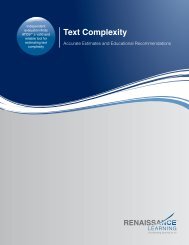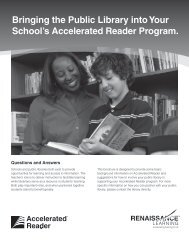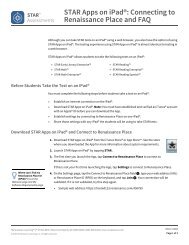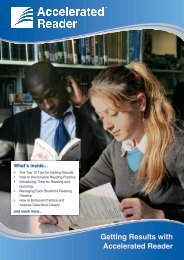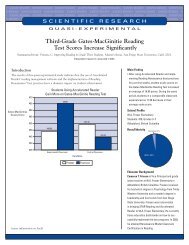Technical Manual - Renaissance Learning
Technical Manual - Renaissance Learning
Technical Manual - Renaissance Learning
Create successful ePaper yourself
Turn your PDF publications into a flip-book with our unique Google optimized e-Paper software.
STAR Early Literacy Enterprise in the ClassroomMeasuring GrowthIn applying the SGP (TAM) approach to STAR data, <strong>Renaissance</strong> <strong>Learning</strong> hasworked closely with the lead developer of SGP (TAM), Dr. Damian Betebenner, ofthe Center for Assessment, as well as technical advisor Dr. Daniel Bolt, an expert inquantitative methods and educational measurement from the University ofWisconsin-Madison. Because SGP (TAM) was initially developed for measuringgrowth on state tests across years, applying the SGP (TAM) approach to interim,within-year assessment data involved a number of technical challenges, primarilythe differences regarding how STAR Early Literacy and state tests areadministered. State summative tests are typically administered once a year, atapproximately the same time, to all students. On the other hand, STAR EarlyLiteracy is much more flexible, and may be administered to students as often asweekly. Decisions on when to administer and which students will participate areleft to local educators. Most commonly, schools use STAR Early Literacy as ascreening and benchmarking test for all or nearly all students 2–4 times per year.Students requiring more frequent progress monitoring may take STAR EarlyLiteracy on a more frequent basis to inform instructional decisions, such aswhether the student is responding adequately to an intervention. Because of thisflexibility, not all students necessarily take STAR Early Literacy at the same time;the number and dates of administration may vary from one student to the next.However, the majority of students test within at least two of the following timeperiods during the school year: fall (August 1–November 30), winter (December1–March 31), and/or spring (April 1–July 31). We chose these date ranges whendefining the data sets that would be used to determine Student GrowthPercentiles. Therefore, we can provide Student Growth Percentiles forachievement that takes place between fall and winter STAR Early Literacy testing,winter and spring STAR Early Literacy testing, and/or fall and spring STAR EarlyLiteracy testing, as defined above.To calculate Student Growth Percentiles, <strong>Renaissance</strong> <strong>Learning</strong> collected hostedstudent data from the two most recent school years (2011-12 and 2012-13). Table60 (on the next page) has details on demographics of these students.STAR Early Literacy<strong>Technical</strong> <strong>Manual</strong>138





